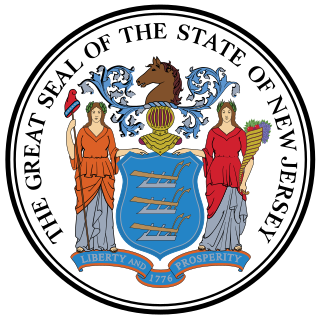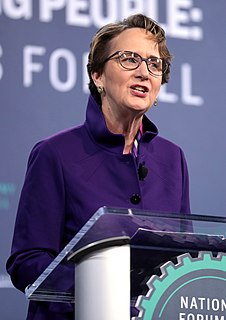
Service Employees International Union (SEIU) is a labor union representing almost 1.9 million workers in over 100 occupations in the United States and Canada. SEIU is focused on organizing workers in three sectors: healthcare, including hospital, home care and nursing home workers; public services ; and property services.

John Joseph Sweeney was an American labor leader who served as president of the AFL-CIO from 1995 to 2009.
Englewood Health is an acute care 289-bed teaching hospital in Englewood, New Jersey.
Sandra Feldman was an American civil rights activist, educator and labor leader who served as president of the American Federation of Teachers (AFT) from 1997 to 2004.

New York State United Teachers (NYSUT) is a 600,000-member New York state teachers union, affiliated since 2006 with the American Federation of Teachers (AFT), the AFL-CIO, and the National Education Association (NEA). NYSUT is an umbrella group which provides services to local affiliates in New York state; lobbies on the local, state and federal level; conducts research; and organizes new members.
Nursing in the United Kingdom has a long history. The current form of nursing is often considered as beginning with Florence Nightingale who pioneered "modern nursing". Nightingale initiated formal schools of nursing in the United Kingdom in the late 19th and early 20th centuries. The role and perception of nursing has dramatically changed from that of "handmaiden" to the doctor to professionals in their own right. There are over 500,000 nurses in the United Kingdom and they work in a variety of settings, such as hospitals, health centres, nursing homes, hospices, communities, and academia, with most nurses working for the National Health Service (NHS). Nurses work across all demographics and requirements of the public: adults, children, mental health, and learning disability. Nurses work in a range of specialties from the broad areas of medicine, surgery, theatres, and investigative sciences such as imaging. Nurses also work in large areas of sub-specialities such as respiratory, diabetes, neurology, infectious diseases, liver, research, cardiac, and stoma. Nurses often work in multi-disciplinary teams but increasingly are found working independently.

Hackensack University Medical Center (HUMC) is a 781-bed non-profit, research and teaching hospital providing tertiary and healthcare needs located seven miles (11 km) west of New York City, in Hackensack, Bergen County, New Jersey. As of 2019, it ranks as the 2nd largest hospital in New Jersey and No. 59 in the US. HUMC is the largest hospital in the Hackensack Meridian Health Health System. It is affiliated with the New Jersey Medical School of Rutgers University and Hackensack Meridian School of Medicine. The medical center is Bergen County's first hospital, founded in 1888 with 12 beds. The hospital is an ACS verified level 1 trauma center, one of five in the state.
Paul F. Clark is a professor of labor studies at Pennsylvania State University. He is head of the Department of Labor Studies and Employment Relations. He also holds a professorship in the Department of Health Policy and Administration.

The Pennsylvania Association of Staff Nurses and Allied Professionals (PASNAP) is a labor union in Pennsylvania that represents about 8,300 nurses and allied health professionals.
The California Nurses Association/National Nurses Organizing Committee (CNA/NNOC), an affiliate of National Nurses United, is a trade union labor union and professional association of registered nurses in the United States. Since 2018, CNA/NNOC has been led by Executive Director Bonnie Castillo, RN.

The New Jersey Department of Health (NJDOH) is a governmental agency of the U.S. state of New Jersey. New Jersey's State Board of Health was established in 1877. Its administrative functions were vested in the Department of Health, which was created in 1947. In 1996, the latter was renamed the Department of Health and Senior Services (DHSS). In 2012, senior services programs moved back into the Department of Human Services, and DHSS again became the Department of Health.
George Hardy was a Canadian-American labor leader who was president of the Service Employees International Union (SEIU) from 1971 to 1980. At the time of his death, SEIU had grown to become the fifth-largest affiliate of the AFL-CIO. Hardy was a vice president of the AFL-CIO from 1972 to 1980, and a member of its executive council. He was a former member of the Democratic National Committee and the California Democratic State Central Committee.

Mary Kay Henry is an American labor union activist who was elected International President of the Service Employees International Union (SEIU) on May 8, 2010. She is the first woman to lead the union. While serving with the union in California, she helped pioneer SEIU's use of card check agreements, non-traditional collective bargaining agreements, comprehensive campaigns, and system-wide health care organizing strategies.
National Nurses United (NNU) is the largest organization of registered nurses in the United States. The NNU, with more than 175,000 members across the country, is the most far-reaching union and professional association of registered nurses in the U.S. Founded in 2009 through the merging of the California Nurses Association/National Nurses Organizing Committee, the United American Nurses, and the Massachusetts Nurses Association, the NNU focuses on amplifying the voice of direct care RNs and patients in national policy. The union's policy positions include the enactment of safe nurse-to-patient ratios, patient advocacy rights at the Executive and State level, and legislation for single-payer health care to secure "quality healthcare for all, as a human right." The organization's goal is to "organize all direct care RNs into a single organization capable of exercising influence over the healthcare industry, governments, and employers."
The Martin Luther King. Jr. County Labor Council, AFL-CIO, (MLKCLC) is the central body of labor organizations in King County, Washington. The MLKCLC is affiliated with the national AFL-CIO, the central labor organization in the United States, which represents more than 13 million working people. Over 125 organizations are affiliated with the MLKCLC, and more than 75,000 working men and women belong to Council-affiliated organizations. Not only does the MLKCLC support labor organizations, but it acts as a voice for the interests and needs of the working people in King County, WA.

Northern Light Maine Medical Center is a hospital located in Bangor, Maine that serves communities throughout central, eastern, and northern Maine. NLNLEMMC is the second largest hospital in the state with 411 inpatient beds, serves more than 40% of the population of the state, and is the sixth largest employer in the state.

The Congress of Industrial Organizations (CIO) was a federation of unions that organized workers in industrial unions in the United States and Canada from 1935 to 1955. Created in 1935 by John L. Lewis, who was a part of the United Mine Workers (UMW), it was originally called the Committee for Industrial Organization but changed its name in 1938 when it broke away from the American Federation of Labor (AFL). It also changed names because it was not successful with organizing unskilled workers with the AFL.
The SEIU Healthcare 1199NW strike of 2014 was a 24-hour strike called by the Service Employees Union healthcare Local 1199NW. The strike was begun on Tuesday, November 18, 2014 at 7:00 A.M. There were 1,100 workers at two Pierce County hospital operated by CHI Franciscan Health in Tacoma participated in the strike event. The two hospitals are St. Joseph Medical Center in Tacoma and St. Clare Hospital in Lakewood. Nurse assistants, licensed practical nurses, unit secretaries, dietary workers, housekeepers, sterile processors, technical workers and other services of the two hospitals were walked off the job to participate in the strike. The strike did not include nurses and doctors. The union members were demanding CHI Franciscan Health to improve wages, improve on health care, improve on their charity care policy, and end unfair labor practices.
Hackensack Meridian Health (HMH) is a network of healthcare providers in New Jersey, based out of Edison. Members include academic centers, acute care facilities, and research hospitals. Hackensack Meridian Health's goal is to create one integrated network that has changes how healthcare is delivered in New Jersey. The network was formed in 2016 by a merger between Hackensack University Medical Center and Meridian Health. Hackensack Meridian Health is affiliated with the Hackensack Meridian School of Medicine and maintains active teaching programs at its hospitals. After the acquisition of JFK Medical Center in Edison, HMH is now the largest healthcare provider in New Jersey.

Striketober is the labor strike wave in October 2021 by workers in the United States in the context of strikes during the COVID-19 pandemic. During the month, more than 100,000 workers in the United States either participated in or prepared for strikes in one of the largest increases of organized labor in the twenty-first century.










